Product Overview Videos
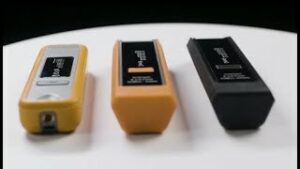
FieldSENSE – A Brief History
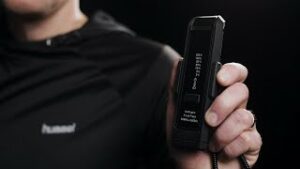
fieldSENSE60 Personal RF Monitor – Overview
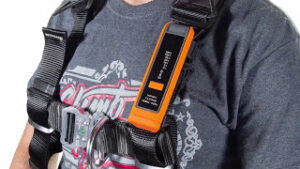
fieldSENSE 2.0 Personal RF Monitor – Overview
FieldSENSE – A Brief History Transcript
Introducing fieldSENSE: The Proven Personal RF Monitor
The fieldSENSE personal RF monitor has evolved significantly over three generations, establishing a strong reputation for reliability, innovation, and performance in personal RF (radio frequency) monitoring.
Generation 1: fieldSENSE 1.0
- Supported frequency measurements from 380 MHz to 2.7 GHz.
- Single-probe architecture suited to early technologies.
Generation 2: fieldSENSE 2.0
- Extended down to 50 MHz for VHF and UHF compliance.
- Upgraded to a 3x E-field and 3x H-field probe array for accuracy.
At development time, frequencies above 6 GHz were mainly point-to-point links, making fieldSENSE 2.0 more than sufficient.
Generation 3: fieldSENSE 60 – Designed for 5G
- Now covers 50 MHz up to 60 GHz for 5G networks.
- Features redesigned probe architecture.
Built for telecom, broadcasting, and EMF safety professionals.
fieldSENSE60 Personal RF Monitor Transcript
fieldSENSE60 Personal RF Monitor
Advanced RF Safety for Modern Networks
- Frequency range from FM broadcast to 60 GHz 5G.
- Real-time exposure monitoring with alerts.
- Harness-attachment system for climbers.
- Weather-resistant and rugged.
fieldSENSE 2.0 Personal RF Monitor Transcript
fieldSENSE 2.0 Personal RF Monitor
Next-generation RF safety monitor for professionals.
- Coverage: 50 MHz – 6 GHz.
- Dual-field measurement (E-field + H-field).
- Smart features: isotropic sensing, fall detection, data logging, voice notes.
- Durable build with riot-shield material.
Instructional Videos
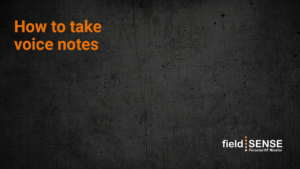
How to take voice notes
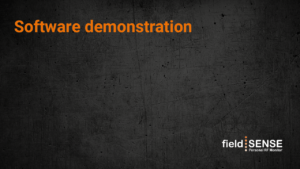
Software demonstration

How the fieldSENSE60 works

How the refurbishment program works
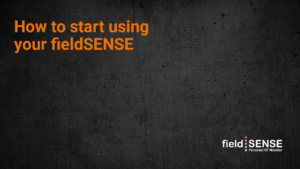
How to start using your fieldSENSE
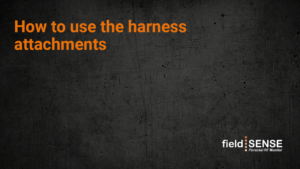
How to use the harness attachments
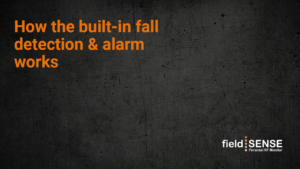
How the built-in fall detection and alarm works
Turning the FieldSENSE personal RF monitor on and off is fast and glove-friendly.
• To power on the device, simply press and hold the main button. The device activates immediately and begins logging RF exposure data without delay.
• To power off, perform the same long press action. The device will shut down cleanly.
This intuitive one-button control ensures ease of use, even when wearing protective gloves in the field.
Accurate RF exposure assessment requires the measurement of both the electric (E-field) and magnetic (H-field) components. This is crucial because, in many real-world scenarios—such as when working near FM radio or television broadcast antennas—you are operating in the near-field rather than the far-field region. In the near-field, the relationship between the E- and H-fields is complex and cannot be inferred from just one component.
To ensure safety, international RF exposure guidelines – such as those from the FCC, ICNIRP, Safety Code 6, and the EU Directive 2013/35/EU mandate a shaped frequency response. This means they account for the human body's increased absorption of RF radiation at lower frequencies compared to higher frequencies.
The fieldSENSE60 is engineered to comply with these standards by:
• Simultaneously measuring E- and H-fields across a wide frequency range,
• Applying frequency-weighted (shaped) response curves in accordance with international guidelines,
• Calculating the cumulative exposure from multiple RF sources in real time.
For example, if you're exposed to both an FM transmitter and a 5G antenna on the same rooftop, the device quantifies the percentage contribution from each source and provides a combined exposure level.
This means you only need to evaluate one clear exposure value, making it easy to determine whether it is safe to work in the area based on the total exposure relative to established limits.
Once powered on, your FieldSENSE personal RF monitor begins logging your exposure environment automatically—with data captured at intervals as frequent as once per second.
To access these exposure logs, including any recorded voice notes:
1. Connect the Device via USB: Use the USB port located at the base of the FieldSENSE device. Open the battery flap to access the port, then connect it to your PC using the provided USB cable.
2. Download and Install the Software: Visit www.fieldsense.com to download the FieldSENSE desktop application. Once installed, launch the app.
3. Automatic Time Synchronization: When connected, the software will automatically sync the device's internal clock with your local time zone, ensuring precise time stamps for all logged sessions.
4. Navigating the Interface: Each recorded session—whether it's an exposure log or a voice note will appear in the left-hand panel. Click on a session to view its contents. Use the graph icon to switch between electric field (E) and magnetic field (H) data, displayed separately for detailed analysis.
5. Exporting Data to Excel: Click "Copy as TSV/CSV" on the right-hand side. You can then paste this directly into Excel for advanced graphing and reporting.
6. Device Management: The app displays the device's serial number. If needed, reset the device by clicking "CLR" in the top-right corner and selecting "Erase Device." This will clear all logs, which is useful for users who frequently log data and want to manage sessions cleanly.
When working at height, a fall can be life-threatening—especially if the worker is rendered unconscious. While a shock-absorbing lanyard system may prevent impact, it does not eliminate the risk of suspension trauma.
To address this, FieldSENSE devices are equipped with a built-in fall detection alarm.
In the event of a fall:
• The device automatically detects the incident.
• It then triggers an audible alarm that continues to sound until manually silenced.
This alarm helps draw immediate attention to the fallen worker's location, enabling faster assistance and significantly reducing the risk of suspension trauma.
This safety feature is part of FieldSENSE's commitment to protecting RF workers operating in high-risk environments.
The fieldSENSE60 features a specially engineered harness attachment system, designed to reduce the risk of device drops when working at height.
The clip assembly consists of two interlocking parts that attach securely to your safety harness:
1. Installing the Harness Clip:
• Start with the smaller rear section of the clip.
• Slide it behind the webbing strap on your harness at the point where you intend to mount the device.
• Then take the front section of the clip and press it firmly into place until the hooks lock in with an audible click.
2. Attaching the Device:
• First, connect the lanyard to the top of the fieldSENSE60.
• Then, pass the other end of the lanyard through the slot in the harness clip base.
• Pull it downward until you hear a click, confirming the lanyard is securely engaged.
Once installed, the fieldSENSE60 is ready for use—safely secured to your harness and protected against accidental drops.
For visual guidance, refer to the illustrated instructions in the official user manual.
FieldSENSE personal RF monitors not only continuously assess and log your RF exposure—they also include a convenient voice note recording feature for field documentation.
Imagine you're on-site and need to quickly capture a serial number or a critical note. Instead of pulling out your phone and risking damage or loss – like dropping it from a tower – you can simply use the FieldSENSE device itself.
To record a voice note:
• Double-tap the button on the device. This starts audio recording immediately.
• Speak clearly into the microphone – for example, to record a serial number or location detail.
• Single-tap the button to stop the recording.
These voice notes are automatically time-stamped and paired with the RF exposure data being logged at that moment.
Once you're back at your workstation, simply connect the FieldSENSE device to a computer. Using the FieldSENSE software, you can easily download and review both your exposure logs and the associated voice notes—helping streamline reporting, compliance, and incident documentation.
FieldSENSE devices are built to endure the demands of daily fieldwork. Over time, however, even the most reliable monitors may show signs of wear – especially when it's time for routine calibration.
That's where the FieldSENSE Refurbishment Program comes in.
When you send your device in through the program, you receive back:
• A fully rebuilt unit,
• Fresh calibration to ensure continued compliance with international safety standards,
• An extended one-year warranty on the refurbished device.
This program ensures your device continues to perform at its best – both functionally and physically.
For more information or to initiate the process, contact your local FieldSENSE distributor.
Frequently Asked Questions Videos
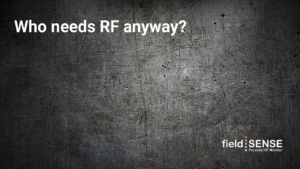
Who needs RF anyway?

Action at a distance
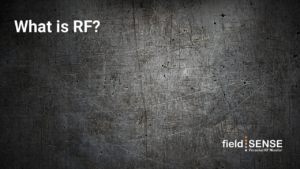
What is RF?

The characteristics of RF
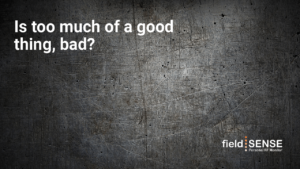
Is too much of a good thing, bad?
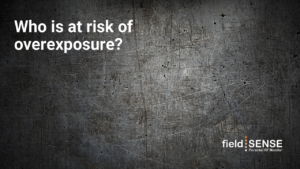
Who is at risk of overexposure?
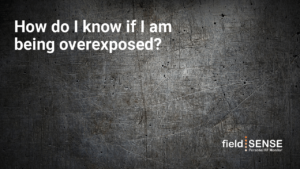
How do I know if I am being overexposed?
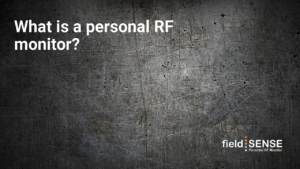
What is a personal RF monitor?

The evolution of telecommunications
Product Features
Isotropic
FieldSENSE personal RF monitors each have a total of six orthogonal E- and H-field probes to ensure that the combination of all sources of radiation from all angles are correctly measured and assessed in accordance with safety limits.
E- & H-fields Measured
RF Safety guidelines use the radiated power density, S in milliWatt/cm2 or Watt/m2, to assess exposure to electromagnetic fields in a given situation. This is derived from the measured E- (electric) and H- (magnetic) fields. To accurately assess a given exposure situation, both of these should be measured, especially when working very low in frequency around FM transmitters for instance. Only measuring E-field in these instances can lead to inadvertent RF overexposure.
Data Logging
The monitors have an advanced E- and H-field data logger, which records all user measurements so that they can be easily accessed over a USB connection to a PC in the office. Additionally, the data can be viewed in real-time over the USB connection with the PC application.
Voice Notes
The inbuilt logging feature allows for quick voice note taking, which can be accessed later in the office. The data is paired with the logged E- and H-fields so specific exposure conditions can easily be tagged.
Shaped Response
The exposure limits, such as the FCC (NCRP), SC6 or ICNIRP limits, are all shaped over frequency. As such, PPE must also have a shaped probe response to accurately measure in accordance with it. RF monitors without a shaped response are inaccurate and can result in an individual being overexposed.
Fall-detection & Alarm
The devices have an inbuilt fall detection system which sounds an alarm should the user accidentally fall. The alarm is easily silenced should the user still be conscious but, should they have been knocked unconscious the sounding alarm will attract the attention of colleagues. This way they are able to immediately initiate rescue actions thus reducing the potential effects of suspension trauma following a fall at height.
User Interface
FieldSENSE devices use high brightness amber LED indicators for direct sunlight visibility and have a loud buzzer to ensure the user won’t miss a thing. Additionally, it is specifically designed to be operated whilst wearing gloves.
Attachments
Devices come with an easily adjustable wrist strap to ensure comfortable attachment while working. Additionally, the fieldSENSE60 harness attachment mechanism has been completely redesigned to include a coiled lanyard system. This facilitates the smooth handling of the device during operations while still remaining visible and audible. Should the device be dropped there is no risk of it falling off the site. A tripod attachment point on the base of the device allows for setting up remote monitoring of a site, or for attaching an extension pole.
AAA batteries
The devices use readily available AAA (LR03) batteries.
“Grippy” design
The device has a custom bevelled design that fits tightly into the user’s hand with a textured soft elastomer surface and grip ridges ensuring no fumble moments.
Rugged IP64 & IK08 Enclosure
The devices have a co-moulded enclosure with a base layer of polycarbonate which is typically used in riot shields, and an outer elastomer layer made of TPU which is designed for hard wearing environments. The design provides for IP64 dust & moisture ingress rating as well as IK08 impact protection.
Zipper Case
Shipped in a heavy-duty zipper case with a custom moulded insert makes for even further protection of the device.
| Feature | Description |
|---|---|
| Isotropic Measurement | FieldSENSE personal RF monitors use six orthogonal E- and H-field probes. These probes detect RF radiation from all angles. This ensures accurate measurement and assessment according to safety limits. |
| Data Logging | FieldSENSE monitors have an advanced E- and H-field data logger. It records measurements for later access via USB. Data can also be viewed in real time on a PC application. |
| Shaped Response | The monitor has a shaped probe response that matches frequency-dependent exposure limits. This ensures accurate measurement. Without a shaped response, users risk overexposure. |
| User Interface | The device uses bright amber LED indicators visible in sunlight. A loud buzzer ensures alerts are noticed. It is designed for use with gloves. |
| AAA Batteries | The device is powered by standard AAA batteries. These are easy to replace and provide reliable power. |
| Rugged IP64 & IK08 Enclosure | The enclosure combines a polycarbonate base with a TPU outer layer. It provides IP64 dust and moisture resistance and IK08 impact protection. |
| E- & H-Fields Measured | The monitor measures both E-field and H-field values. This ensures accurate power density calculations, especially at low frequencies such as near FM transmitters. |
| Voice Notes | The logging feature allows quick voice note recording. Notes link to the logged data for easy review. |
| Fall Detection & Alarm | The device has fall detection. It sounds an alarm if the user falls. This alerts colleagues to assist quickly. |
| Attachments | Includes an adjustable wrist strap and coiled lanyard. A tripod mount allows remote monitoring or pole attachment. |
| Grippy Design | The bevelled design with textured elastomer and grip ridges ensures a secure hold. |
| Zipper Case | The device comes in a heavy-duty zipper case with a protective moulded insert for safe transport and storage. |
Software Download
fieldSENSE60
fieldSENSE 2.0








